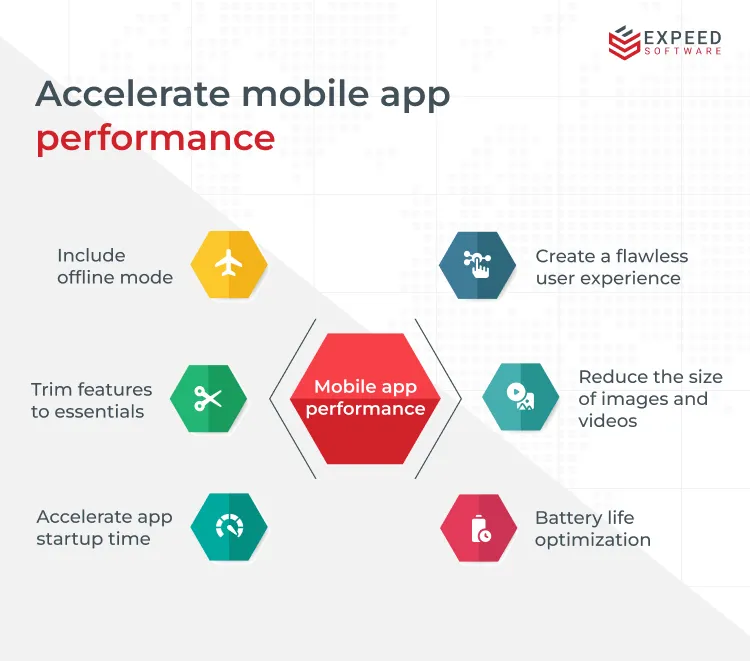Optimizing mobile apps is the only way to get your apps up and running successfully. However, this does mean collating a bundle of things like – satisfying user experience, using clean codes, maintaining a small app size, ensuring the security of the app’s source code, and a lot more. Proper app optimization means getting all these activated so that your mobile app puts out superior performance. As traditionally assumed, the work of a mobile app does not end with its creation. It is not considered complete and functional by just creating it. To ensure that it showcases superior performance, mobile apps needs to be optimized.
Only continuous optimization on-the-go will ensure that it gets the necessary downloads and user engagements. But, yes, of course, this is not easy-peasy. It does involve a lot of back-end and front-end activities to make sure it is speedy, efficient, and responsive enough.
As per the statistics of a Market Analysis Report, the global mobile application market size was valued at USD 228.98 billion in 2023 and is expected to grow at a compound annual growth rate (CAGR) of 14.3% from 2024 to 2030.
The above statistics reveals an exponential growth in this market, and hence there is going to be high competition to stay ahead. The only way to get these apps to make their way to potential users ‘attention and use’ is to get these mobile apps optimized.
Let’s figure out some of the best practices to get a mobile app optimized and all-ready for the user.
Key Practices for Mobile App Optimization

Create a Flawless and Seamless User Experience
Creating a great user experience is the first step to mobile app optimization. This is essential to retain users as well as to ensure that new users keep flocking to you. This means that the user should be able to use and navigate through the app effortlessly without much hiccups. Applications like these should be able to deliver this kind of a flawless experience so that users find it easy to get to their end result. The interface should be self-explanatory and quick enough to guide the user to their final destination.
Reduce the Size of Images and Videos
By using small-sized images and videos, your app speed and responsiveness can be improved, and this is another way to get your mobile application optimized. Developers need to keep this in mind while creating a mobile application. Large-size images takes time to load, which can easily frustrate the user, who might abandon using the app halfway through. This can increase cart abandonment ratios, reflecting the poor performance of the application.
Battery Life Optimization
An effective mobile application should never be a battery-life guzzler. A highly optimized mobile app should use only optimal battery life and should not drain the user’s battery faster than usual. A battery-friendly mobile application is one that is minimalistic in the use of codes, algorithms, computations, memory usage, and more. Another approach would be to use simple animations and transitions while working on the UI design.
Reduce the Startup Time of the App
As always, first impressions are the best impressions, and this is true for mobile applications too. One way to make the first impression of your application truly memorable is to ensure that it launches quickly and without much delay. This is one simple way to ensure that the overall impression of your application is far more appealing to users and visitors in contrast to those whose launch time can go up to more than 15 seconds. This can instantly improve user and visitor traffic to the app.
No, No to Superfluous Features
Apps can be feature-rich, but it is essential to ensure that they do not deviate their focus from their actual goal. Too many features will not only slow down its speed, activity, and responsiveness, but they will eventually lead to its poor performance. Hence, a good-performing application should only have the required number of features to be operational.
Have an Offline Mode Too
Having an offline mode is yet another way to get your mobile app optimized. An offline mode means users still get to access data in cases of no or poor connectivity. This will hook users to keep using the app rather than quitting it. However, only a few features can be accessed in this mode. So, it’s definitely a bonus to have an offline feature for your app.
Tools to Get Your Mobile App Optimized
Now that we have discussed some of the ways in which to optimize a mobile app, let’s also understand some of the popular tools that can be used for optimization. Mobile apps are seen to be mushrooming, and today, there is a mobile app for every small business or enterprise, and this has eventually led to a huge market for mobile app optimization tools too. This market is flooded with such tools, and there is no looking back for such tools. This has led to heavy competition, and each of these tools is struggling hard to get noticed and stay ahead of the competition.
Let’s list out some of the popular tools that can be used to optimize mobile applications.
ProGuard
You have developed an app, and now you are on the lookout for some tool to shrink its code so that it is finally short, sweet, and refined. Do you also want to ensure that the app is easy to download and that its loading time and space are at a bare minimum? Don’t worry, because you have landed in the right place. Proguard is a popular mobile app optimisation tool that can work wonders for your app. You may not know it, as it works from behind the curtains to shrink, optimize, and obfuscate your app’s code so that now it’s tinier, quicker, and more secure. ProGuard can clean up the mess in your app’s code by organising it so that it is clean, neat, and good-to-go. Using ProGuard ensures that your app uses less space on your device and can be downloaded in record time. It also ensures that your app runs smoother and more efficiently. And the final feather to the cap of this tool is that it makes sure that the app will no longer be a playground for hackers to play around with.
So, in short, ProGuard acts like an armour for your app, protecting it and making sure that it delivers outstanding performance.
ImageOptim is Just Right for Your Images
Let’s check out another mobile app optimization tool that can wonders when it comes to images. Use it if you have an app that uses a lot of images. This tool can easily reduce the size of large images, allowing you to accommodate multiple images all the while by maintaining their quality. It can also be used on all kinds of digital platforms and is especially useful for platforms that play around with a lot of images. They work to reduce image size, which in turn improves the loading time of web pages, reduces bandwidth usage, and improves the user experience. It also supports a wide variety of image formats, like JPEG, PNG, GIF, and a lot more.
R8 Ensures Your Codes are Optimized Well
Code shrinking is an essential way to optimize mobile apps as it decreases the app’s download size, leading to faster installation and reduced storage space on users’ devices. This ensures the app is as light as a feather. The way R8 works ensures that the app is free of any kind of interference from hackers, making sure that it is tough to extract any sensitive information. It ensures that information and data are secured, and IP rights are protected.
Lighthouse
This is yet another tool that can do mobile app optimization based on loads of data that it collects to arrive at reports and metrics that can help in various optimization efforts to improve the app’s overall speed and responsiveness. The data generated from Lighthouse can be easily used for SEO optimization activities by ensuring that meta tags and page titles are used effectively. This tool also ensures that the concerned app is used extensively and ranks well in search engine results. The reports from this tool can fix issues that are likely to affect the app’s overall quality and user experience.
To sum It Up
Optimizing mobile apps in the right manner ensures that the mobile platform that uses these apps feels light and occupies very little storage space. Getting it optimized also means that the performance and activity of your app improves drastically, which can in turn scale your business to unimagined heights. Mobile app optimization does not happen in just a single sitting, it is a continuous process that requires regular activity. It can easily transform the way we live and communicate with the world around us. It is a way to boost productivity both in our personal and professional lives. Mobile apps are the present as well as the future and so the need to get them optimized is just so real, true and essential.
Expeed Offers Mobile App Optimization Services
Expeed has been involved in providing mobile optimization services to regional and international clients across the globe. Our clients have shown great appreciation in our mobile app optimization works and has gone overboard by recommending it to their associates too. Some of our highly satisfied clients have gone overboard by returning to us to use many of our other services too.

